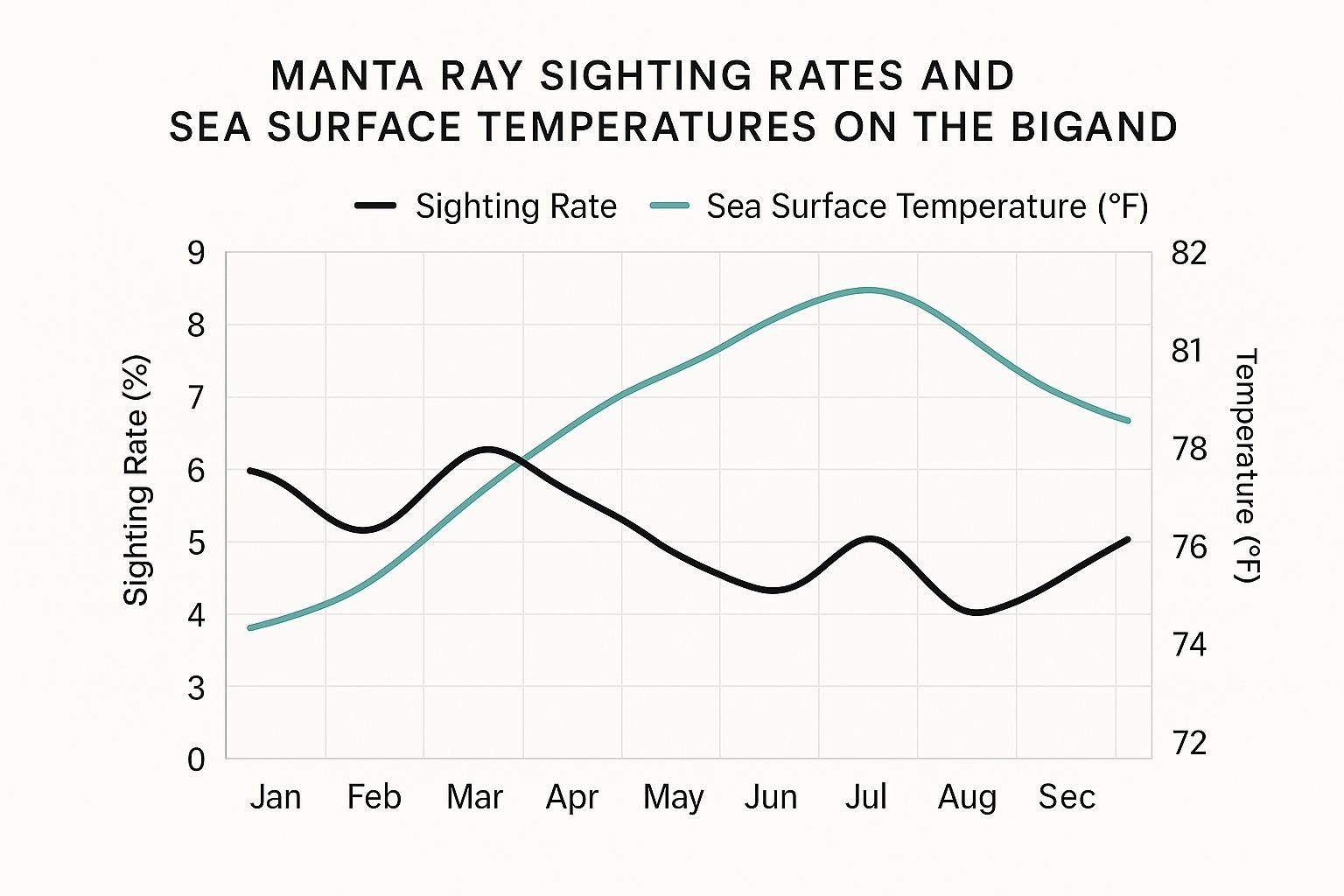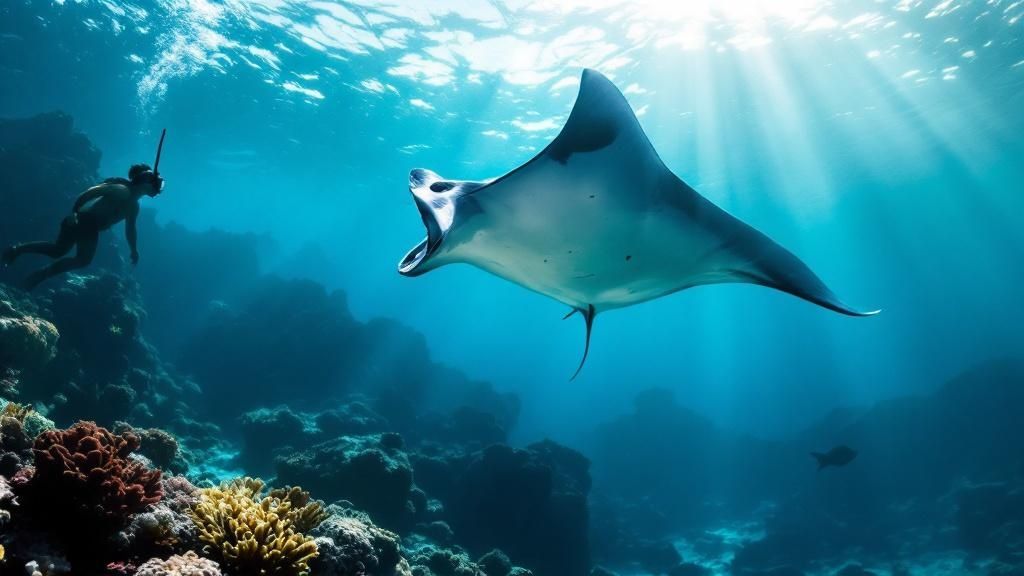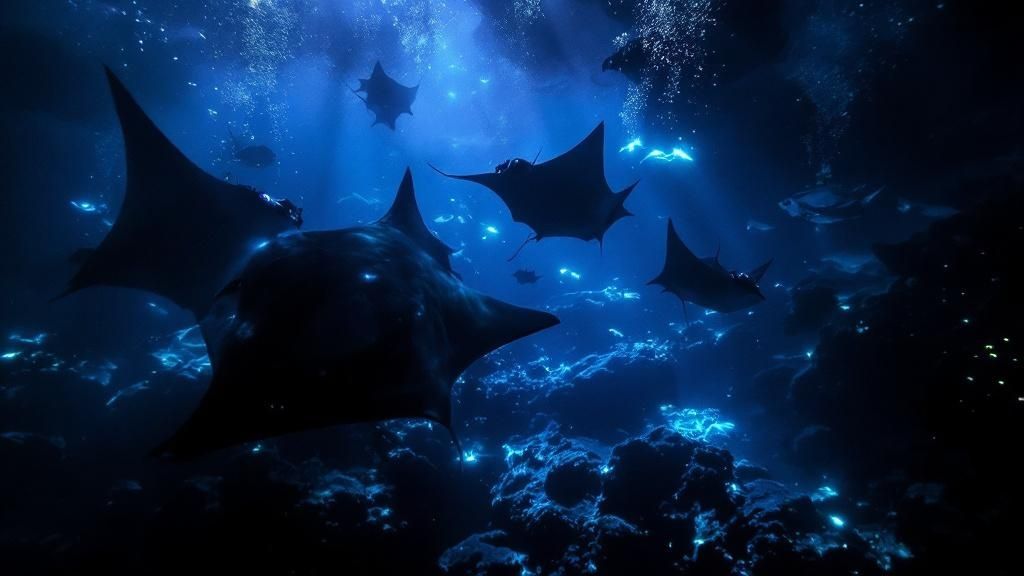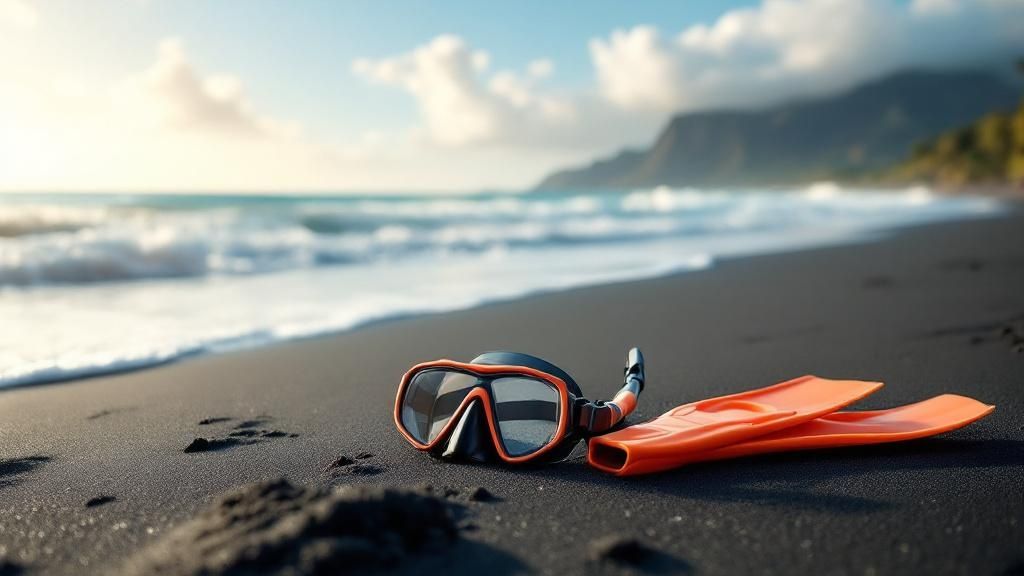Manta Ray Snorkel Big Island: A Must-Do Underwater Adventure
- Byron
- Jun 21
- 12 min read
Why Kona’s Waters Are Unlike Anywhere Else on Earth
Imagine floating in warm, crystal-clear water while creatures the size of small airplanes glide gracefully beneath you like living shadows. This isn’t a scene from a movie—it’s a nightly reality off Hawaii's Kona coast. But what makes these waters so special? The answer is a perfect mix of geology and environment that has created a true underwater paradise, making the manta ray snorkel Big Island experience famous worldwide.
A Geological Recipe for Success
The magic starts with the island's volcanic past. Over thousands of years, lava flows from the Hualālai and Mauna Loa volcanoes sculpted the seafloor, creating unique underwater landscapes. These ancient lava formations became natural, amphitheater-like coves and bays. These sheltered areas are not only calm and protected from open-ocean currents but are also ideal nurseries for plankton, the microscopic organisms that manta rays love to eat. This geological layout acts like a magnet, drawing in a massive and reliable food source for the mantas.
Unlike other spots around the globe where sightings can be seasonal or unpredictable, Kona's unique setup provides a consistent, year-round buffet. This reliability is the main reason it has earned its reputation as the world's best manta ray destination. The Kona Coast has an incredible 85-90% sighting success rate all year, supported by a healthy local population of over 450 individually identified manta rays. These numbers show why so many travelers consider this a must-do adventure. You can learn more about Kona's amazing manta population from local experts at Kona Honu Divers.
To put Kona's unique status into perspective, let's compare it to other well-known manta ray destinations. The table below highlights just how special the Big Island is for consistent and high-volume manta encounters.
Location | Success Rate (%) | Population Size | Best Season | Average Mantas Per Tour |
|---|---|---|---|---|
Kona, Hawaii (USA) | 85-90% | ~450 resident | Year-Round | 4-8 |
Maldives | 70-80% | ~5,000 migratory | May-November | 2-5 |
Socorro Island, Mexico | 60-70% | ~500 migratory | November-May | 1-3 |
Lady Elliot Island, Australia | 50-60% | ~1,200 migratory | May-August | 1-3 |
Nusa Penida, Indonesia | 40-50% | ~1,000 migratory | April-October | 1-2 |
As you can see, while other locations have larger migratory populations, Kona stands out for its high success rate and year-round viewing season, thanks to its resident manta population. This means you have an excellent chance of an unforgettable encounter no matter when you visit.
The chart below shows just how consistent manta ray sightings are, alongside the comfortable sea temperatures throughout the year.

As the data shows, sighting rates stay incredibly high month after month, proving that any time is a great time to witness this natural wonder.
From Accidental Discovery to Iconic Attraction
The final piece of this amazing puzzle was a bit of human intervention. Decades ago, a coastal hotel installed bright lights that lit up the water, accidentally attracting swarms of plankton. The local manta rays quickly discovered this nightly feast, and a new, reliable feeding ground was born.
Tour operators soon realized they could create the same effect with their own underwater lights, leading to the spectacular encounters we see today. This partnership between natural geography and a learned manta behavior turns every night into an opportunity for a breathtaking underwater ballet, transforming visitors into lifelong ocean advocates.
Getting To Know Your Swimming Companions
Before you glide into the dark Hawaiian waters for your manta ray snorkel Big Island tour, it’s helpful to get acquainted with the incredible creatures you're about to meet. Manta rays are much more than just large fish; they are intelligent, inquisitive animals with fascinating social lives and even individual personalities. Think of them as the wise, gentle giants of the reef, boasting one of the largest brain-to-body mass ratios of any fish. This advanced brainpower helps explain why they often show genuine curiosity toward people.
The Graceful Giants of the Reef
What you are about to see is a beautiful and effective feeding spectacle. Manta rays are filter-feeders, which means their diet consists of huge amounts of microscopic plankton. The powerful lights used by tour boats attract these tiny organisms, and the mantas simply follow their food source, creating a mesmerizing underwater ballet. They glide, loop, and perform somersaults through the illuminated water, their giant mouths open to strain their dinner from the sea. This feeding behavior isn't just about survival; it’s an elegant dance perfected over millions of years.
The image below captures the impressive wingspan and unique body shape that allows for such fluid movement.

This body structure, with its powerful pectoral fins acting like wings, is what allows them to "fly" through the water with such acrobatics and grace.
Personalities in the Water
Just like us, every manta ray has its own unique personality. Seasoned guides in Kona can actually recognize individual rays by the distinct spot patterns on their bellies, which serve as natural fingerprints. Over the years, they’ve even given many of them names. Some mantas, like the locally famous “Big Bertha” or “Lefty,” are known for being bold and swimming very close to snorkelers. Others are more shy, choosing to dance and feed at a slight distance.
Recognizing these individual differences changes the experience from just observing large fish into a personal interaction with these remarkable ocean dwellers. You can learn more about what makes the Kona manta experience so special by digging deeper into the lives of these gentle giants. This knowledge helps you appreciate the small details of their behavior, turning your snorkel into a truly unforgettable encounter.
Decoding The Best Manta Ray Hotspots

The two most famous and dependable sites are affectionately known as Manta Village and Manta Heaven. Let's explore what makes each one special.
Manta Village: The Welcoming Introduction
Just south of Kailua-Kona, in Keauhou Bay, you'll find Manta Village. This spot is often recommended as the best starting point for a reason. Its location near the Sheraton Kona Resort & Spa means it has a long history of light attracting plankton, which in turn attracts the mantas. Tour operators add their own lights, creating a reliable underwater buffet.
Shallow and Sheltered: The water here is generally calmer and not as deep, making it a comfortable choice for first-time night snorkelers and families with kids.
High Success Rate: This is one of the most consistent manta ray viewing sites in the world, with a sighting success rate that regularly tops 90%.
Shorter Boat Ride: Tours often leave from Keauhou Bay, so you spend less time traveling on the open ocean and more time floating with the mantas.
Manta Heaven: The Grand Amphitheater
Further north, near the Kona International Airport, is Manta Heaven, also known as Garden Eel Cove. This site offers a different flavor of spectacle. While also very reliable, the ocean conditions can be a bit more unpredictable. The big draw here is the potential for huge numbers of mantas. On a good night, Manta Heaven can feel like an underwater amphitheater, hosting a swirling vortex of graceful giants. The show can be truly epic, but it often takes place in deeper water and can feel more exposed than Manta Village.
To help you choose the location that best suits your group's comfort and adventure level, we've put together a simple comparison chart. This table breaks down the key features of each site at a glance.
Big Island Manta Ray Snorkeling Sites Comparison
Detailed comparison of the top manta ray snorkeling locations including depth, difficulty level, best conditions, and typical encounter experiences
Location Name | Average Depth | Skill Level | Best Conditions | Typical Group Size | Unique Features |
|---|---|---|---|---|---|
Manta Village | 25-35 ft | Beginner | Calm & protected bay | Smaller to medium | Consistently calm waters and very high sighting success rate. Ideal for families and first-timers. |
Manta Heaven | 30-45 ft | Intermediate | Calm seas | Medium to large | More exposed, but has the potential for larger numbers of mantas, creating a truly grand spectacle. |
Ultimately, both Manta Village and Manta Heaven offer incredible opportunities to see these gentle giants. Manta Village provides a more predictable and sheltered experience, making it perfect for those seeking a calm introduction. Manta Heaven appeals to the more adventurous snorkeler who is comfortable in slightly deeper, more open water and dreams of seeing a massive manta gathering.
The Research Revolution Behind Reliable Encounters
Have you ever wondered how tour operators can practically guarantee you'll see manta rays on a manta ray snorkel Big Island tour? It’s not luck or magic; it’s the result of decades of careful scientific work. This research has turned a chance encounter into a predictable and breathtaking experience, giving you an incredibly high probability of meeting these gentle giants. It all starts with a simple but effective way to tell them apart.

From Fingerprints to Feeding Forecasts
Researchers made a key discovery: the unique spot patterns on a manta ray’s belly are just like human fingerprints. No two are the same. By taking pictures and creating a catalog of these belly spots, scientists have identified and even named hundreds of individual rays that live around Kona. This huge database lets them track specific mantas over many years, revealing some very useful patterns.
This long-term data helps answer important questions that make your tour better:
Do certain mantas prefer one feeding site, like Manta Village, over another?
Does their feeding activity change with the phases of the moon?
Are some mantas more "social" and more likely to interact with the lights?
By understanding these details, tour operators can make smarter decisions, almost like creating a daily feeding forecast. This scientific method has proven to be extremely successful. For example, a detailed study between 2009 and 2014 had researchers diving at night up to seven times a week, carefully noting which mantas showed up where. This consistent data gathering has been essential for understanding the population's health and movements. You can learn more about this incredible work from the team at Manta Ray Advocates.
Why Science Matters for Your Snorkel
This research goes far beyond just improving your chances of seeing a manta ray. It also involves tracking their health and migration, which helps operators understand what conditions they prefer and predict the best times and locations for a great encounter. Scientists have confirmed that mantas return to their favorite feeding grounds with remarkable regularity—a behavior that tour companies now rely on to plan their nightly trips.
This partnership between science and tourism doesn't just promise you an incredible night; it also supports the conservation work needed to protect these magnificent animals for years to come. To see how this research can help you plan your trip, check out our guide on the best time to see manta rays in Kona.
Finding Your Perfect Manta Ray Experience
With so many tour operators on the Big Island claiming to offer the adventure of a lifetime, how do you pick the one that's actually right for you? The trick is to see past the marketing and understand what each company truly provides. Choosing an operator is like picking a guide for a mountain expedition; the right one not only keeps you safe but shapes the quality of your entire journey.
Big Boat vs. Small Group: What's the Difference?
Your first big choice often comes down to the size of the operation: a large vessel or a small-group tour. This decision will significantly influence your manta ray snorkel Big Island experience.
Large Tour Boats: These bigger boats can hold more people and often come with more amenities, like onboard restrooms or snack services. However, this can make the experience feel less personal. With more snorkelers in the water, it might be tougher to get a clear, unobstructed view of the mantas.
Small-Group Tours: Often run on smaller boats or nimble zodiacs, these tours offer a more intimate and tailored adventure. With fewer guests, guides can give more individual attention, answer all your questions, and make sure everyone gets a prime spot at the underwater "campfire" of lights. This usually results in a calmer, more meaningful encounter.
Regardless of their size, the best operators invest in their teams. They provide continuous training for their guides, maintain smaller guide-to-guest ratios, and prioritize safety above all else, without making the trip feel sterile. They are also skilled at adapting to the ocean's conditions in real-time instead of just following a rigid plan.
Sunset Tour or Full Night Experience?
The next decision is about timing. Most companies have two main options: a sunset tour and a later tour that takes place in complete darkness.
Sunset Tours: These are a great choice for nervous first-timers or families with younger kids. You'll head out while it's still light, enjoy a spectacular Kona sunset from the boat, and then slip into the water as twilight settles. This gradual transition into the dark can help ease any anxieties.
Full Night Tours: For a more dramatic and striking experience, the later tours are hard to beat. Under a sky blanketed with stars, the sharp contrast between the dark ocean and the bright underwater lights is truly stunning. This option is ideal for those who are completely comfortable swimming in the ocean after dark.
As you do your research, read online reviews with a critical eye. Look for consistent praise about the guides' expertise and safety measures, not just comments about seeing mantas. Before you book, don't be shy about asking about their manta guarantee—many reputable companies will offer a free second trip if no mantas show up. Vague answers about safety or high-pressure booking tactics are red flags. Making a well-researched choice is the best way to ensure your adventure lives up to your dreams.
Setting Yourself Up For An Incredible Encounter
The difference between a good manta ray snorkel and a truly magical one often boils down to how you prepare. It’s about more than just knowing how to swim; a few specific techniques and the right mindset can completely change your adventure. Feeling a bit nervous beforehand is totally normal—after all, you're about to float in the dark ocean while giant creatures glide just inches away!
Physical and Mental Readiness
Your physical comfort plays a bigger role than you might expect. If you don't snorkel often, try to spend a little time in calm, shallow water beforehand, just getting used to your mask and snorkel. This simple practice builds confidence, which is a huge help when you want to focus on the mantas, not fuss with your gear.
Once you’re in the water, your most important job is to stay calm. Imagine you're a log floating peacefully on the surface. The less you move, the more comfortable the mantas will feel around you. This stillness not only keeps you safe but also encourages the rays to come closer for an unforgettable view.
Being mentally ready is just as important. Knowing what to expect helps you relax and stay in the moment. Here are a few tips to make a huge difference:
Prevent Seasickness: If you sometimes get motion sickness, think about taking an over-the-counter remedy well before you get on the boat. Even on a short trip, the ocean can get a little choppy.
Stay Warm: The ocean water can feel chilly after a while, even with a wetsuit. A wetsuit that fits snugly is crucial. Most tours provide them, but it’s a good idea to confirm your size when you book. A pro tip is to bring a windbreaker or a warm sweater for the boat ride back to shore.
Handle Imperfect Conditions: Sometimes the water might be a little murky, or the mantas might be feeling shy. Go into the experience with an attitude of gratitude for whatever nature has in store. Remember, many operators offer a "manta guarantee," which means you can re-book for free if no mantas show up.
What to Bring (and What to Leave Behind)
Packing light but smart makes for a much smoother trip. Your essentials should include a swimsuit (wear it under your clothes to save time), a towel, and a dry change of clothes for after. However, some things are better left behind. Avoid wearing shiny jewelry, as it can catch the light and be mistaken for small fish, attracting the wrong kind of attention.
Above all, the most important thing to bring is a calm, respectful attitude. When you show up prepared and ready to be a quiet observer, you're setting the stage for an incredible and memorable encounter with Kona's gentle giants.
Beyond The Adventure: Cultural Connection And Conservation Impact
Your manta ray snorkel Big Island experience connects you to something much larger than a thrilling wildlife encounter; it plugs you into a deep current of culture and conservation. These graceful giants are not just marine animals; they are deeply woven into the fabric of Hawaiian heritage. In traditional Hawaiian culture, these creatures, known as **hahalua**, are revered as sacred beings symbolizing wisdom and protection. They are seen as **ʻaumākua**, or spiritual guardians, that bridge the gap between the ocean and the sky. This ancient reverence continues today, with many local communities feeling a profound spiritual link to the mantas that grace their shores.
Your Tour, Their Future
This cultural respect has beautifully evolved into a modern conservation success story. Think of your snorkel tour as a direct investment in the future of these magnificent animals. The industry has become a powerful economic engine, transforming a wildlife viewing activity into a force for good. Annually, approximately 80,000 tourists visit Kona specifically for these encounters, making manta ray tourism a cornerstone of the local ecotourism economy.
The revenue from responsible tours directly supports research, habitat protection, and vital education programs that ensure these gentle giants thrive for years to come. This economic impact ripples throughout the Big Island, supporting the livelihoods of boat captains and guides, filling local restaurants, and sustaining hotels that host thousands of visitors drawn here by the promise of a manta ray ballet. This success, however, shines a spotlight on the importance of choosing tour operators who put conservation first.
A Legacy of Respect
By participating in a responsible tour, you become part of a larger story of **mālama** (to care for and protect). You are actively supporting a sustainable tourism model that honors both ancient Hawaiian values and the delicate marine ecosystem. Your adventure is more than just a memory; it’s a contribution that helps protect the hahalua for generations to come, ensuring the magic you witness remains for others to experience. The best operators share this vision, blending adventure with a deep sense of responsibility. You might be interested in our guide covering expert tips for an epic snorkel to ensure your experience is respectful and amazing.
Ready to be part of this incredible story of adventure and conservation? Book your unforgettable night with the gentle giants of Kona.
[Book Your Manta Ray Night Snorkel Tour Today!](https://www.mantaraynightsnorkelhawaii.com)
Comments